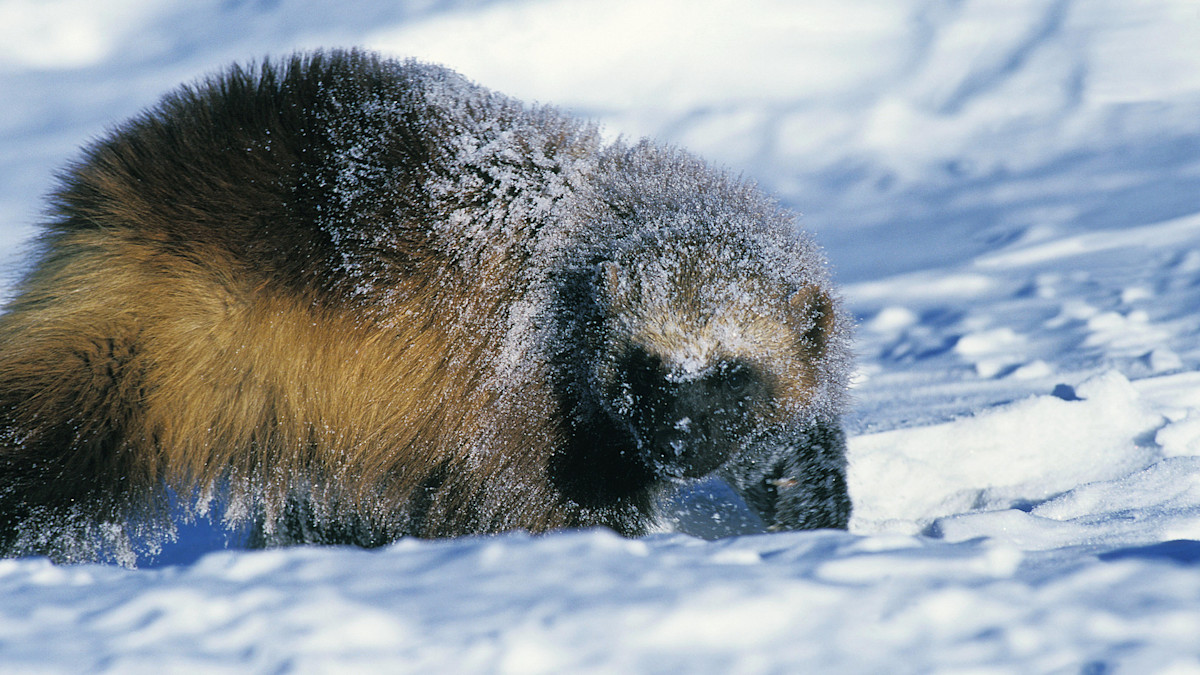
On November 30, the United States Fish and Wildlife Service (USFWS) announced additional protections for wolverines, listing the species as “threatened” under the Endangered Species Act (ESA). The new listing prohibits the harvest of wolverines, but a proposed incidental take rule would allow wolverines to be killed as bycatch related to legal wolf-trapping activities.
Conservation organizations are celebrating the ruling as a crucial step in the recovery of the species. Some of these organizations, however, are already hinting that the new designation could be used to limit wolf trapping.
Wolverines have long been at the center of a heated conservation debate in the Rocky Mountain West. Currently, there are a mere 318 animals thought to live in the Lower 48—a recovery from near extinction in the 1920s. Remarkably, the species returned to the landscape naturally via migration south from Canada, with no human-aided reintroductions.
As part of the road to recovery, legal trapping of wolverines is currently banned in the continental US (Alaska and Canada both allow for trapping). And while the new listing doesn’t change that, it might provide the legal fodder needed by conservation organizations to put a stop to wolf trapping that occasionally results in incidental wolverine harvest.
It wouldn’t be the first time conservation groups have fought tooth and nail for the species. In fact, the new ESA listing comes on the heels of nearly 20 years of litigation over the protections afforded for wolverines. Notably, in 2013, the USFWS proposed listing wolverines as threatened but reversed course a year later.
Then, in 2020 under the Trump administration, they conducted a full “species status assessment” and determined that wolverines were not in need of listing—under the grounds that “the factors affecting the species as identified in the 2013 proposed rule were not as significant as believed at the time of publication of the proposed rule.” Namely, habitat loss due to climate change, incidental trapping of wolverines, and inbreeding as a result of small and isolated populations.
Shortly after, the Center for Biological Diversity and WildEarth Guardians filed lawsuits challenging the assessment. The lawsuits were consolidated, and the environmental groups won in May 2022, forcing the USFWS to once again commence the process of listing wolverines as threatened.
As part of the listing process, the USFWS revisited the species assessment, and identified several potential threats to wolverines. The primary threat: habitat loss as a result of climate change. Wolverines are highly mobile predators, especially in winter when their huge paws allow them to cover vast distances (dozens of miles) in a single day. Loss of snowpack limits their mobility and potentially their ability to scavenge for prey as a result.
Also listed as a potential threat is the incidental trapping of wolverines as bycatch from legal wolf trapping. In the Rocky Mountain West, the USFWS acknowledges that “new wolf trapping laws in Montana and Idaho may have the potential to increase the amount of incidental capture of wolverines,” specifically in reference to recent increases in season lengths, wolf tags available per person, and monetary incentives for trapping wolves.
However, the USFWS goes on to say that “we expect recent changes to wolf trapping regulations in Idaho and Montana to have little effect on wolverines at a population level, as long as trapping is done in a manner to limit wolverine bycatch.” Currently, most western states already have restrictions in place to limit accidental wolverine harvest, such as trap size and tension limits. In fact, since 2012, there have only been 10 wolverines taken in traps in Montana, resulting in three mortalities. In Idaho, between November 2017 and August 2022, there were nine wolverines trapped, which resulted in two mortalities.
Despite this, attorneys working on behalf of environmental groups already appear to be gearing up to fight for even stronger protections—namely, some kind of a ban or reduction in wolf trapping under the pretense of protecting wolverines. Numerous environmental groups have already issued statements hinting at such action.
Matthew Bishop, an attorney with the Western Environmental Law Center, doesn’t mince his words: “We are concerned about the allowances for trapping in wolverine habitat. We doubt it’s possible to trap without the risk of take. Wolverines—a crucial species for many ecosystems throughout the western U.S.—deserve the fullest protections possible. Given the small population and climate change quickly shrinking the snowy habitat wolverines rely on to survive, time is of the essence.”
Mike Garrity, executive director of the Alliance for the Wild Rockies, is equally as explicit: “We appreciate that the Fish and Wildlife Service finally listed wolverines as threatened but their 4d rule, which allows trapping in wolverine habitat, is a road map for extinction, not recovery. Wolverines are scavengers and will continue to be taken if trapping is allowed to continue. The Fish and Wildlife Service needs to follow the law like all Americans are required to do and come up with a plan to recover wolverines.”
At the end of the day, conservation groups would like to see wolverines hit their carrying capacity in the West: an estimated 644 animals. That would require expanding the current range of the species to other states where wolverines are currently extirpated—places like Colorado and Nevada. Some groups and wildlife management agencies are already tossing around the idea of reintroduction campaigns, particularly in Colorado, where deep snowpacks provide excellent wolverine habitat.
But as conservation groups ramp up their efforts, wolf trapping might be in jeopardy. Already this year, a federal judge in Missoula truncated Montana’s wolf-trapping season in response to a lawsuit from WildEarth Guardians arguing that it puts grizzly bears at risk—another species listed as “threatened.” It’s a safe bet that the group will use a similar argument with wolverines and wolf trapping in the near future. It’s certainly something we’ll keep an eye on.
The new wolverine listing becomes effective on January 2. However, the USFWS is seeking public comment on the incidental-take rule exception until January 29.




